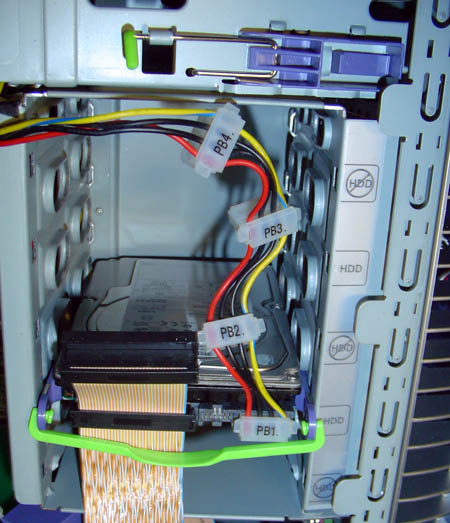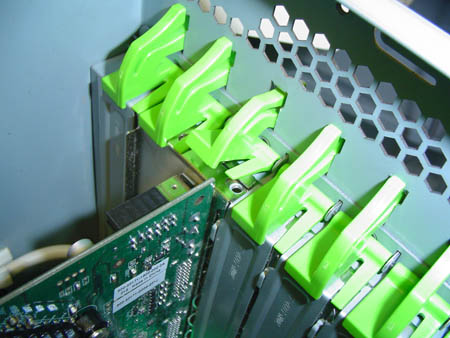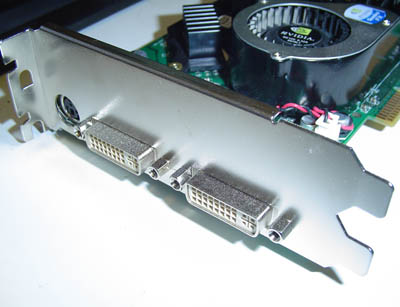Sun's W2100z Dual Opteron Workstation
by Kristopher Kubicki on October 27, 2004 12:05 AM EST- Posted in
- Systems
Putting It All Together
The immediate difference between a whitebox configuration and the Sun w2100z is the level of design and attention to detail. Our w2100z only comes with one system fan, a 120mm exhaust. An 80mm exhaust fan provides cooling inside the power supply, and each processor also incorporates 80mm fans in their design - we will go into more detail about the heatsink fan (HSF) design in the thermal section of the analysis. There are no intake fans on the workstation. Sun relies on enormous amount of passive cooling for the workstation. For example, only two hard drives may be placed in the system and they must be placed a bay apart from each other. You can see an example of this below.You can see from the image that alternating bays are marked for cooling rather than hard drive storage. Two hard drives may seem like the bare minimum for a performance workstation, particularly if any sort of PVR work is in order, but the fact that Sun can passively cool both drives and the rest of the machine without any intake might be a design win in itself. Also notice the somewhat unique screwless plastic rails on the drive. Pulling the green handle unclips the purple rails and allows us to slide out the drive.
As long as we are on the subject of tool-less design, we were also particularly impressed with Sun's approach to the expansion bay. Below, you can see the green retention clips holding the PCI/AGP cards in place.
Removing an expansion card requires us to pinch the green clip from the outside of the case and then lift it up. For those of you who follow our case reviews closely, this is an excellent, well thought out design. Cable management was not as perfected as some other system builds that we have seen in the past, particularly along the power supply. While not overwhelming, Sun could use a slight bit of improvement in this area, particularly since they have gone through so much care to label and document each port and cable clearly on the system.
Although the tool-less design of the case is an excellent design win, the heavy weight of the system was surprising. The Sun website lists the shipping weight of the workstation at just under 60lbs! Most of this weight seems to stem from the all-steel construction of the case - the motherboard mounting plate seems almost to be reinforced with additional steel. Additional steel may have some passive cooling qualities, but we do not have the ability to test that theory. The aluminum front bezel deceives us into thinking that the workstation is much lighter than it really is, but then again, most people don't lug their high end workstations around after the initial setup all that often anyway.

Below you can see the standard IO specifications for the system. Again, keep in mind the included keyboard and mouse use up 2 of the 5 USB ports.
| Sun w2100z System Specifications | |
| 5.25" Expansion Bays | 3 |
| 3.5" Expansion Bays | 4, 2 usable |
| Rear USB Ports | 3 |
| Forward USB Ports | 2 |
| Rear Firewire Ports | 1 |
| Forward Firewire Ports | 1 |
| On-Board Parallel Port | 1 |
| On-Board Game Port | 0 |
| On-Board Serial Ports | 2 |
| Front Audio Jacks | 1 in, 1 out |
| Rear Audio Jacks | 1 in, 1 out |
| SPDIF | 1 |
| Number of Fans (including CPU/chipset) | (1) 120mm exhaust (2) 80mm CPU |
| Power Supply | 550W AcBel |
Sun included various other components for our analysis of the w2100z. The included QuadroFX 3000 (~GeForceFX 5900) is important for our OpenGL SpecViewperf benchmarks, but can be upgraded fairly easily. Our FX 3000 is a dual DVI video card, but Sun includes two DVI to D-sub 15 dongles for CRT users.
Our Sun w2100z can make use of 16GB of PC-3200 DDR by default. We are only using 4GB of buffered ECC memory as seen below. The Micron DIMMs utilize a BGA chip design.














47 Comments
View All Comments
najames - Friday, October 29, 2004 - link
I use a Sunfire V440 daily at work. It is a 4cpu large entry level server seen here.http://store.sun.com/CMTemplate/CEServlet?process=...
I program daily on mainframe, Solaris, and PC. Benchmark programs I wrote took 38cpu seconds on the mainframe, 38cpu seconds on my PIII pc, 17cpu seconds on Solaris. Four programs submitted at once on the the mainframe took 38cpu seconds but wall time was hours, the PC choked, the Solaris server still did them in 17cpu seconds each in about the same wall time. The Solaris server didn't slow down, period. We have combined large programs that individualy would sometimes crash on the mainframe and the Solaris Unix server burns through them even with temp space going over 12gigs druing processing.
If the Sun Opteron server is anything like my little Sunny, they sould do very well.
Reflex - Friday, October 29, 2004 - link
*laff* Something tells me thats not the case.My curiosity is just that since these are obviously relabels, I am wondering who the original manufacturer is as the hardware is excellent and it might be nice to be able to acquire these for white box systems.
morespace - Friday, October 29, 2004 - link
Egad. You're absolutely correct. I didn't notice the daughterboard arrangement in that picture at first. It looks flat. But looking more closely at the placement of chips and capacitors on those motherboards, it's more than a family resemblance - they appear identical!I sense a conspiracy.
The hard drive enclosures appear different for what it's worth. Who makes these really? Apple?
Reflex - Friday, October 29, 2004 - link
I take that back, that is the same as the one I have on my bench, however their cabling is a bit more messy.Look closely. Anandtech did not show a straight out picture from the same angle, but thats the same motherboard in more or less the same chassis with a few modifications. The CPU, chipset, Adaptec chip, PCI and AGP slots are all in the same places on that board, both use the daughtercard method for the CPU, etc.
Thats why I am asking who actually makes that board and case, someone is preconfiguring the servers and Sun/IBM are labelling and reselling them.
Reflex - Friday, October 29, 2004 - link
That is not the same Intellistation that I have on my lab bench. I'll look up the model number when I go back in, but seeing as its friday night that won't be till monday.morespace - Friday, October 29, 2004 - link
Reflex, what are you on about? Here's a picture of the insides of an IBM Intellistation A Pro:http://www.digitalcad.com/articles/viewarticle.jsp...
Tell me, how does this look like a w2100z?
Nsofang - Friday, October 29, 2004 - link
Zealots on both sides always mess up any discussion. This is a review about the Sun WORKSTATION, yet punks bring in supercomputer arguments. WTF!! is wrong with you guys! If anything bring in arguments/discussions about comparable hardware G5's/Itaniums/NEC/SGI, something that adds to the discussion, not subtract.slashbinslashbash - Thursday, October 28, 2004 - link
#33: You're right, for "general purpose computing" FLOPS is a pretty bad measure, but you've just changed your argument. For "high-end workstations" (what this argument is supposedly about) FLOPS can be *very* relevant, depending on the application.#34: I meant "nothing special" in terms of how supercomputing clusters are normally hooked up. Just a few years ago, Gigabit Ethernet cards cost $200, and their most prominent application was in supercomputing clusters.
Reflex - Thursday, October 28, 2004 - link
#37: Yeah, I know, I was in a mood yesterday or I wouldn't have let him get me into it. ;)And you just made the point I was trying to make. While price can be an issue in the corporate space, its only the deciding factor when all other factors are equal. I was not even trying to get into a Mac vs. PC debate, this really has nothing to do with Mac's.
I do want to know who is building these workstations though, because its not Sun despite the label.
bob661 - Thursday, October 28, 2004 - link
Reflex,He's trying to pull you off the subject. Supercomputers are irrelevant in this discussion. The thread is about workstations. Sun markets workstations. Apple does not. I know our company doesn't care about a couple hundred or even a couple thousand dollar difference if the service is impeccable and the workstation performs the task without headaches.